Discover
BROKEN CHAIR
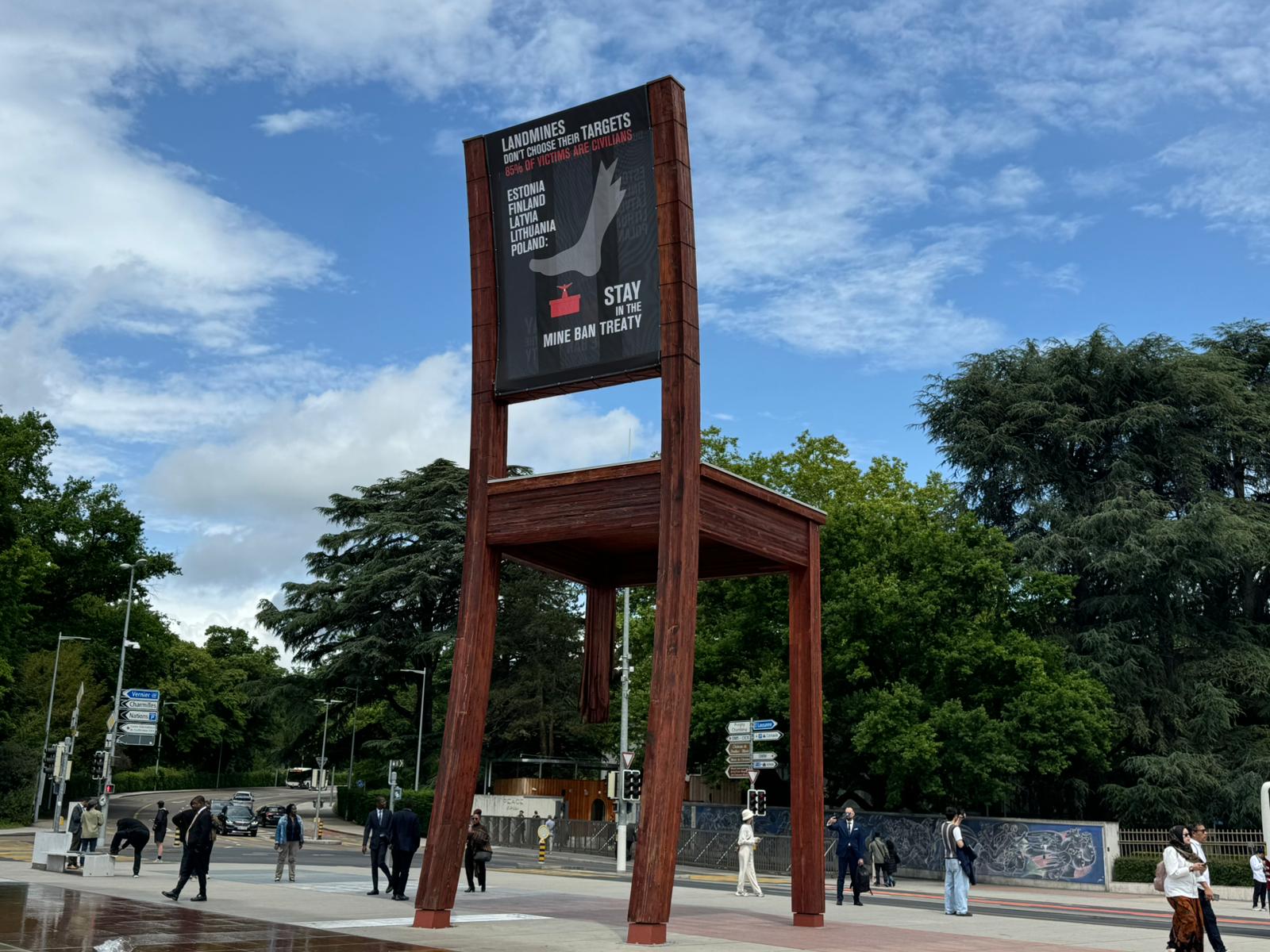



A powerful message is now displayed on the Broken Chair monument: “STAY IN THE MINE BAN TREATY.”
Installed by Handicap International and the International Campaign to Ban Landmines (ICBL), a banner calls on Estonia, Finland, Latvia, Lithuania and Poland to reconsider their plans to withdraw from the Mine Ban Treaty.
With the implementation review conference of the treaty taking place from 17–20 June, the banner will remain throughout the month—standing as a bold reminder of what’s at stake:
- Global norms designed to protect civilians during conflict will be weakened as states decide to set past legal obligations aside due to a “changed security environment.”
- EU unity on banning these weapons will be fractured.
- Civilians in conflict zones will face increased dangers, as landmines kill and maim indiscriminately for decades..
The Broken Chair—long a symbol of protest against landmines—is once again at the heart of this critical call to action.
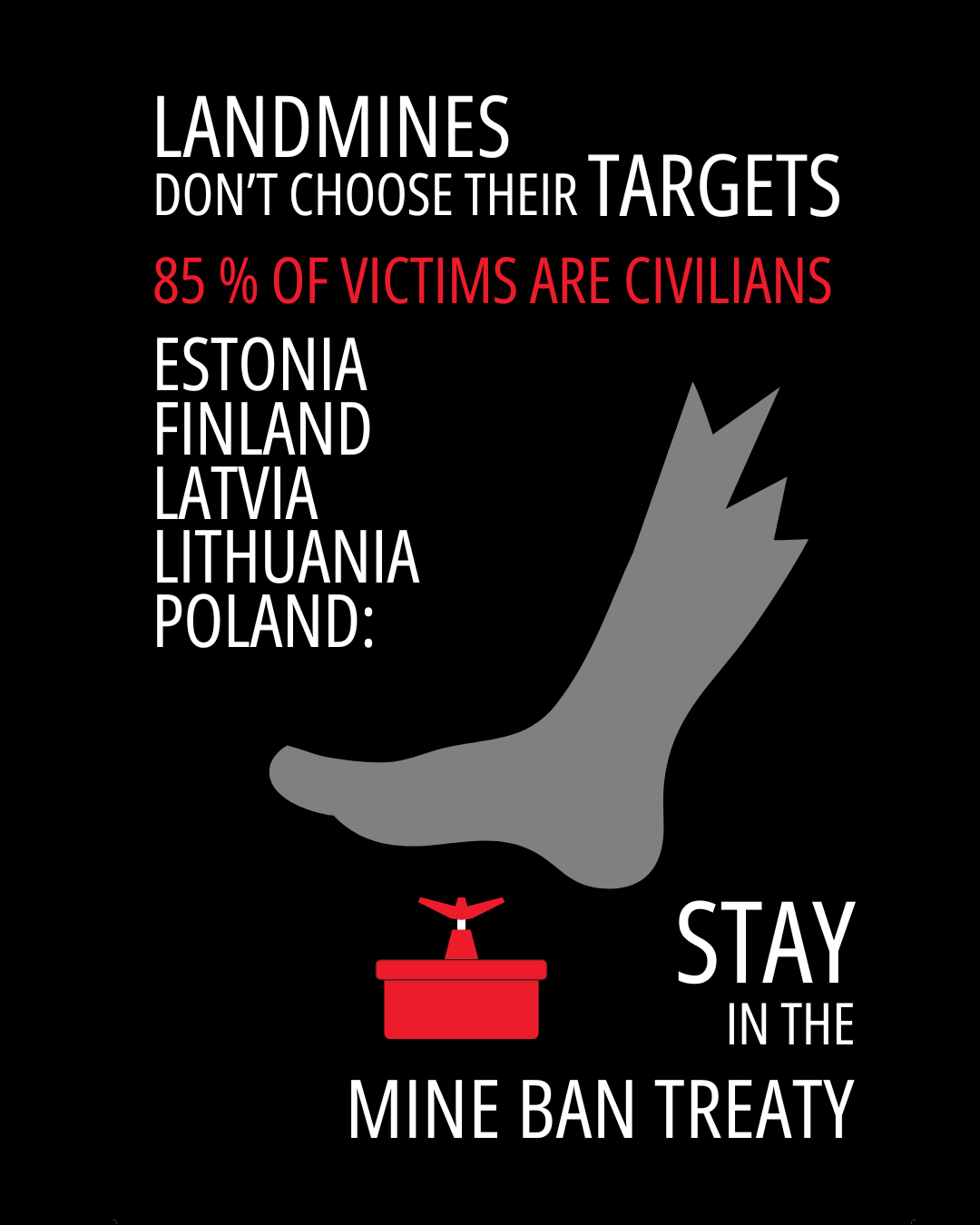



ABOUT
Broken Chair : symbol for armed violence victims
Broken Chair embodies the desperate but proud cry of the civilian populations harmed by all forms of armed violence. It also symbolizes the obligation of States to protect and help the victims. Its presence on the Place des Nations allows each of us to develop a personal reflection on our responsibility to refuse the unacceptable, and to act!
Created : 1997
Size and weight : 12 meters and 5.5 tons
Material : Douglas Wood
Owner : Handicap International, Humanity & Inclusion
Project : Paul Vermeulen, co-founder of Handicap International Switzerland
Artist : Daniel Berset
Carpenter : Louis Genève
Engineer : Thomas Büchi
History
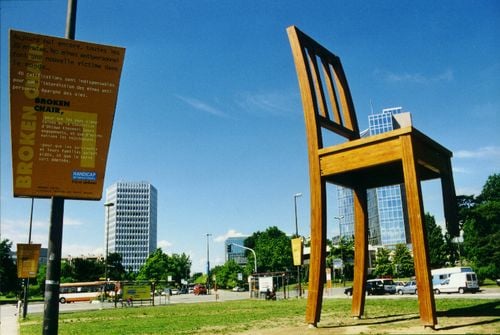 1997
1997 18 August - Broken Chair comes to Place des Nations
This giant chair was born out of Handicap International’s desire to rally states and public opinion to put an end to the humanitarian crisis caused by antipersonnel mines.
18 August - Broken Chair comes to Place des Nations
This giant chair was born out of Handicap International’s desire to rally states and public opinion to put an end to the humanitarian crisis caused by antipersonnel mines.
"The idea was to attract the public's attention by creating a powerful message that cannot be rejected by Geneva authorities. To speak of such a sensitive subject, one has to go through a symbol." - Paul Vermeulen, co-founder of Handicap International Switzerland.
Originally, Broken Chair was to be installed for a few months and taken down in December 1997 once the Ottawa Treaty prohibiting the acquisition, production, stockpiling and use of antipersonnel mines was signed. Yet thanks to its popularity, the sculpture has remained on Place des Nations.
An uncertain future
The renovation of Place des Nations again threatened Broken Chair’s presence. "While for the architects, the artwork integrated perfectly their visual concept
The renovation of Place des Nations again threatened Broken Chair’s presence. "While for the architects, the artwork integrated perfectly their visual concept of the renovation of the square, pressure for its removal came from certain international spheres." - Paul Vermeulen.
On the initiative of Handicap International, a support movement was organised to bring back the artwork, which had rapidly gained international renown.
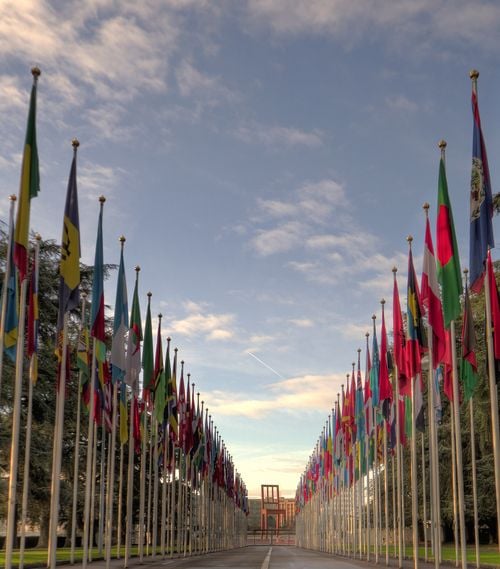 2007
2007 February 26 - Broken Chair returns
Beyond the debate about its future, Broken Chair returned to its original location thanks to a groundswell of popular demand.
Beyond the debate about its future, Broken Chair returned to its original location thanks to a groundswell of popular demand.
"You don't get rid of symbols so easily. Its return had provoked heated debate at the heart of international organizations. But a wide support has made Daniel Berset's work an icon in the fight against mines and cluster bombs, as well as a place of expression of all injustices." - the daily newspaper Le Temps.
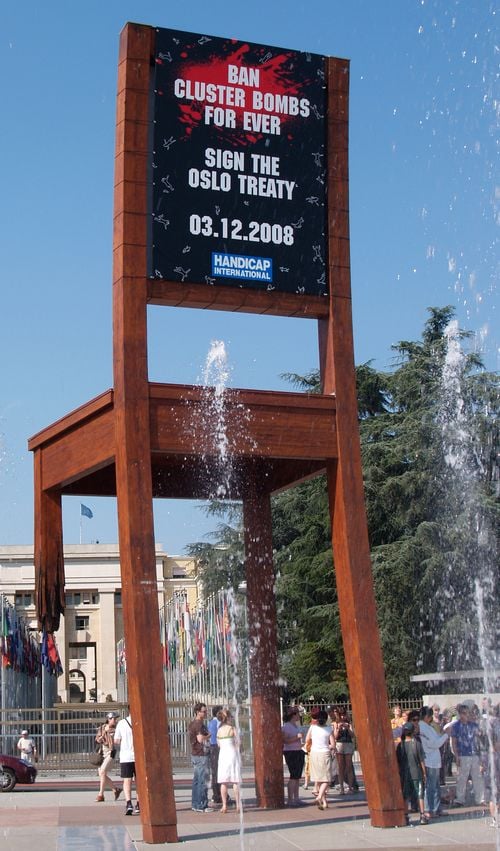 2008
2008 Broken Chair working for victims of cluster bombs
Handicap International extended the work’s symbolic power in support of the process to ban cluster bombs, which were subsequently banned by the Oslo Convention in December 2008.
Handicap International extended the work’s symbolic power in support of the process to ban cluster bombs, which were subsequently banned by the Oslo Convention in December 2008.
A new battle for Broken Chair: explosive weapons
Handicap International chose a new role for Broken Chair. As part of its “NO to the bombing of civilians” campaign, the monument now embodies the desperate cries of those maimed by military violence, with reference to the use of explosive weapons in populated areas.
Handicap International chose a new role for Broken Chair. As part of its “NO to the bombing of civilians” campaign, the monument now embodies the desperate cries of those maimed by military violence, with reference to the use of explosive weapons in populated areas.
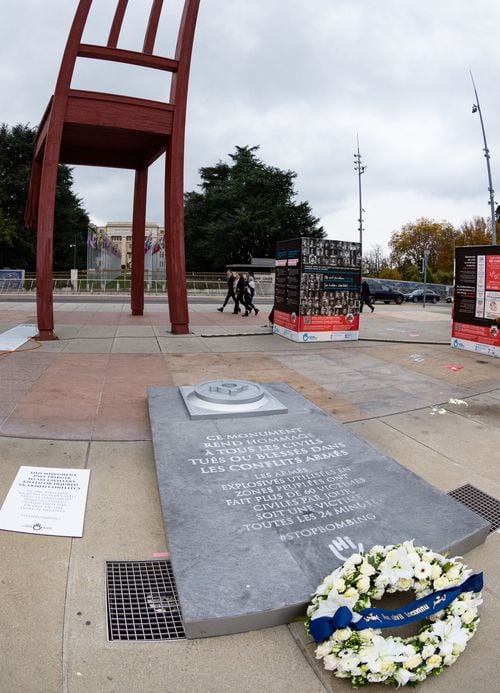 2019
2019 November 14 – Symbolic inauguration of the monument to the Unknown Civilian
As a key witness to the ravages of explosive weapons and in keeping with its foundational opposition to weapons that kill civilians, Handicap International symbolically inaugurated the Monument to the Unknown Civilian in honour of the millions of women, men and children who have unjustly died in the shadow of war.
As a key witness to the ravages of explosive weapons and in keeping with its foundational opposition to weapons that kill civilians, Handicap International symbolically inaugurated the Monument to the Unknown Civilian in honour of the millions of women, men and children who have unjustly died in the shadow of war.
 2020
2020 January 31 – A sad return to the news
Following the announcement made by U.S. government to resume the use and storage of anti-personnel mines, Handicap International...
Following the announcement made by U.S. government to resume the use and storage of anti-personnel mines, Handicap International organized an awareness campaign under Broken Chair to call on the signatory states of the Ottawa Treaty to use all their influence to get the United States to reverse this outrageous decision.
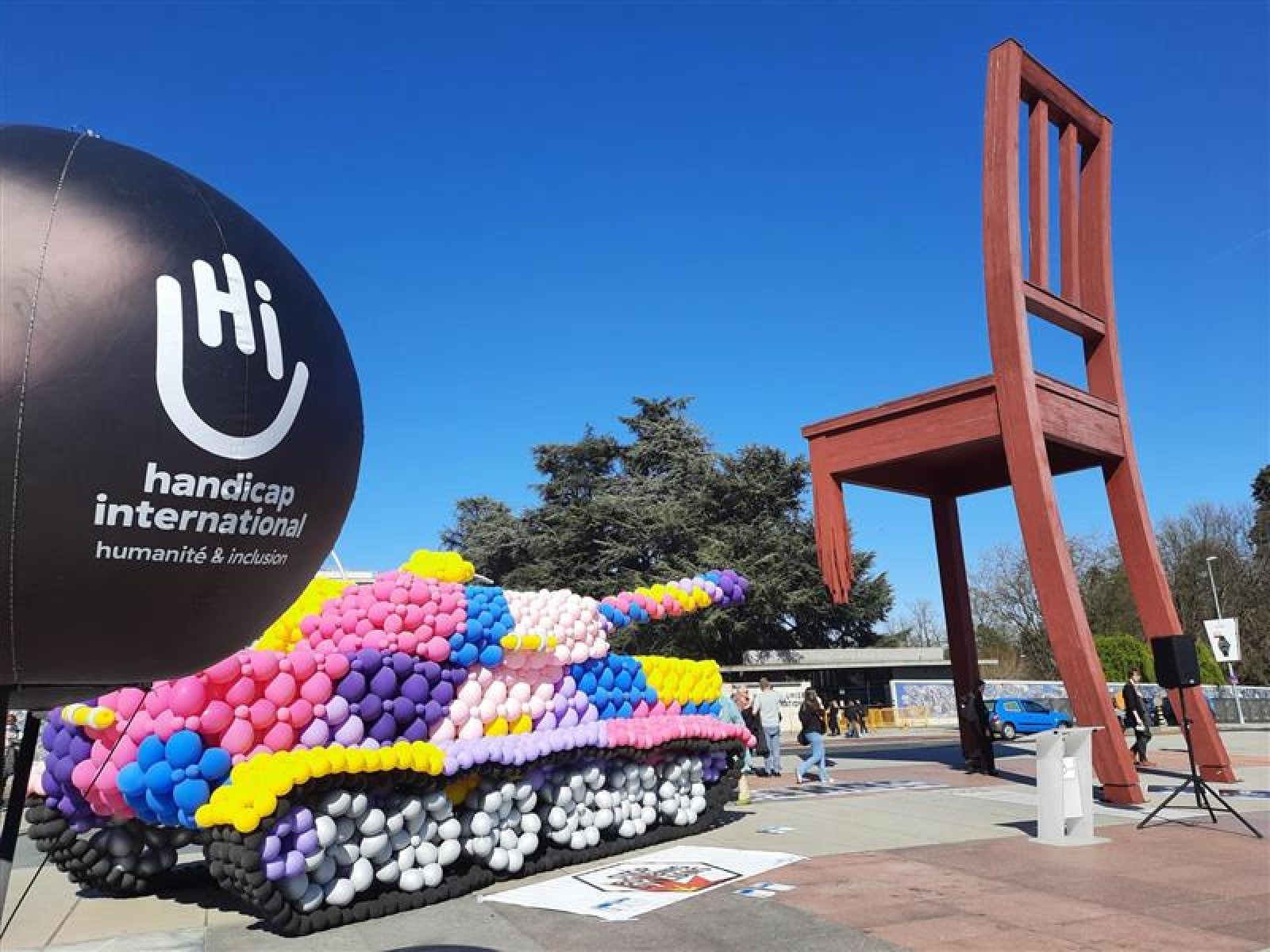 2022
2022 Real progress in ending civilian suffering due to bombing
Handicap International positioned a “balloon tank” next to Broken Chair to draw attention to the final negotiations to end the bombing of civilians in populated areas.
Handicap International positioned a “balloon tank” next to Broken Chair to draw attention to the final negotiations to end the bombing of civilians in populated areas.
The ensuing discussions led to real progress. States now recognise that the use of explosive weapons in populated areas has an unacceptable humanitarian impact on civilians and that there is an urgent need to better protect them from this practice.
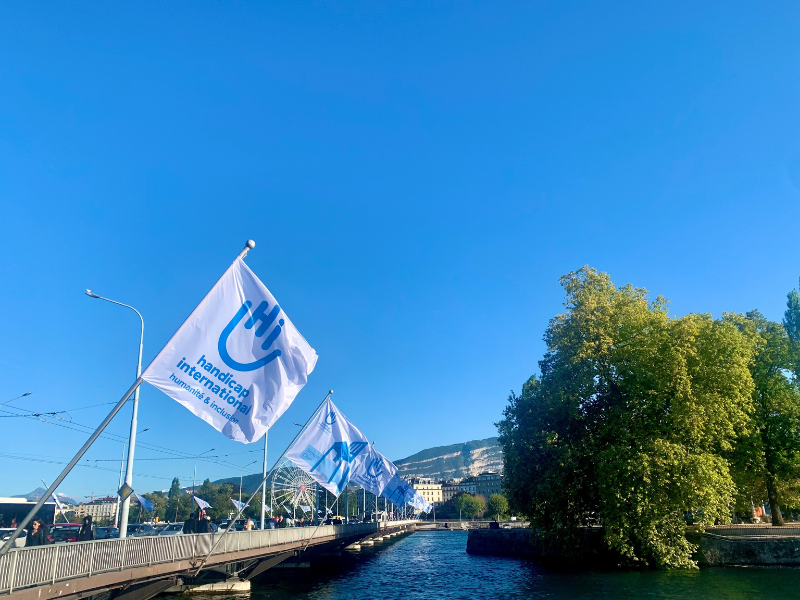 2022
2022 September - Commemorating 25 years of Broken Chair
In order to raise awareness of barbaric practices such as the bombing of civilians and to continue to unite people around its fight to protect civilians
In order to raise awareness of barbaric practices such as the bombing of civilians and to continue to unite people around its fight to protect civilians, Handicap International organised the "Broken Days" campaign, which became part of the history of Broken Chair. Throughout September 2022 in Geneva, to mark the 25th anniversary of Broken Chair, an exhibition retraced the history of the chair's struggles. The flags on the Mont Blanc bridge and the water jet were in HI colours.
4 to 15 September - All of us ! Art against weapons
Franco-Swiss artist Saype has teamed up with Handicap International...
Franco-Swiss artist Saype has teamed up with Handicap International to raise awareness of the fight against the bombing of civilians around the world. To mark the occasion, Saype has created a gigantic fresco in eco-responsible paint entitled "All of us!”. With a surface area of 1,000 m², the work was located on the Place des Nations in Geneva, which was specially grassed over for the occasion. It depicted a hand pretending to repair the missing part of the Broken Chair sculpture using a fourth leg.
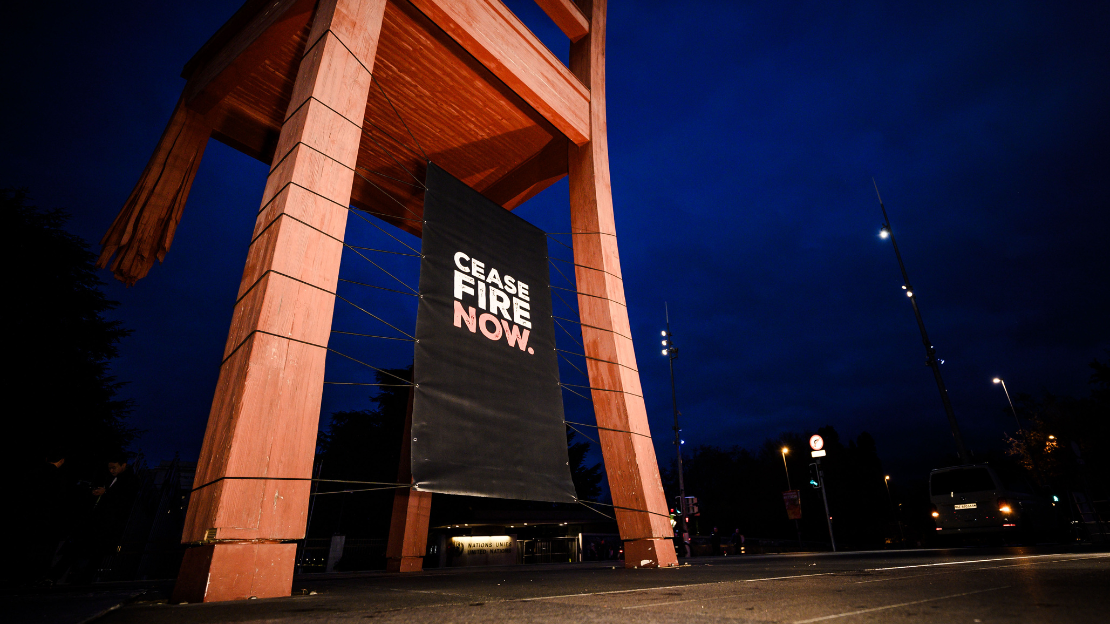 2023
2023 21 November - The call for an immediate ceasefire in the Gaza Strip and Israel from Geneva.
The humanitarian crisis and the massive loss of life in the Gaza Strip and Israel have deeply shocked the international community.
The humanitarian crisis and the massive loss of life in the Gaza Strip and Israel have deeply shocked the international community. We have joined forces at the feet of Broken Chair with CARE, Intersos, Médecins Du Monde Switzerland, Médecins Sans Frontières, and Terre des hommes Lausanne to support the call for an immediate ceasefire, to prevent the humanitarian catastrophe from worsening.
 2024
2024 Restoring Broken Chair
Broken Chair was last restored in 2016, and is now in need of restoration. Because of its organic material, it lives and transforms like a human being vulnerable to weapons.
Broken Chair was last restored in 2016, and is now in need of restoration. Because of its organic material, it lives and transforms like a human being vulnerable to weapons. This work will be carried out by specialist companies throughout July 2024. The companies include Louis Genève and Thomas Büchi, both of whom worked on the creation of the Broken Chair 27 years ago. Artist Daniel Berset will also be involved.
Funding for the restoration is being provided entirely by companies and foundations keen to preserve this monument to international Geneva, the voice of victims of explosive weapons around the world.
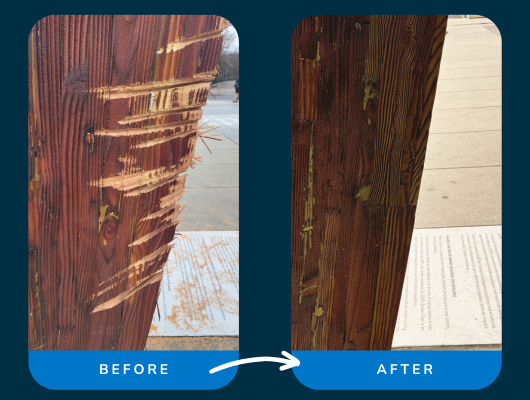 2025
2025 Broken Chair under repair
As Handicap International's spokesperson for the victims of the bombings, Broken Chair once again bears deep scars following an act of vandalism in December 2024.
As Handicap International's spokesperson for the victims of the bombings, Broken Chair once again bears deep scars following an act of vandalism in December 2024. Handicap International repaired the Broken Chair between March 24 and April 4, 2025.
Vandalized but still standing
On December 13, 2024, Broken Chair was vandalized by activists with a chainsaw. This act left deep gashes in this powerful symbol of the fight against landmines and the protection of civilians. Handicap International, owner of the chair, quickly contacted the companies behind its creation in 1997 and its latest restoration in 2024.
For Thomas Büchi, master carpenter, the damage is significant:
“The damage is serious, and it will take several weeks to repair this emblematic work by artist Daniel Berset. The repairs can only begin in the spring, as temperatures above 12°C are necessary to ensure proper adhesion of the new wood."
Q&A
- Why did the repairs have to wait until spring?
The wood of the sculpture requires temperatures above 10-12°C to allow for durable gluing and finishing.
- Why not leave the scars visible?
Master carpenter Thomas Büchi explains: "If we leave the scars, the wood could deteriorate over time."
- Why aren’t those responsible paying for the damages?
The activists arrested were sentenced to financial penalties. However, the material damages remain the responsibility of Handicap International. We chose not to pursue civil litigation in order to focus our efforts on the restoration.
- Why doesn’t insurance cover the damage?
Specific clauses related to public art include strict conditions. In this case, the damage is not covered by insurance.
- Who is financing the repairs?
We extend our gratitude to the City of Geneva, as well as private partners and foundations, who contributed to covering the CHF 15,000 repair cost.
Access
Adresse
Broken Chair
Place of Nations
1202 Geneva
Public transport / Nations decision
Stop : Nations
